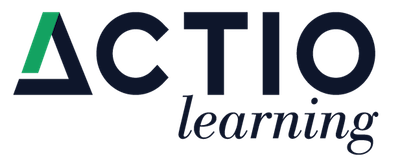AI is no longer a futuristic concept—it’s actively reshaping how knowledge workers operate today. (What is a knowledge worker? Knowledge workers are those requiring analytical thinking, decision-making, and expertise in fields like banking, insurance, and professional services.)
Across industries like banking, insurance, and professional services, AI-driven automation, predictive analytics, and machine learning are revolutionizing job roles.
But while AI is eliminating repetitive tasks, it’s also expanding the scope of human work, shifting employees toward high-value responsibilities such as strategic decision-making, complex problem-solving, and customer advisory services.
For Learning & Development (L&D) leaders, this transformation presents an urgent challenge: how to reskill and upskill the workforce for AI-enhanced roles? Organizations that proactively adapt will gain a competitive advantage, while those who lag may struggle to retain.
How AI is Transforming Knowledge Worker Roles
AI is driving significant changes in knowledge-intensive roles, impacting how employees work and interact with technology. The viability of L&D’s services increasingly rests on its ability to play a pivotal role in employee development and job performance.
1. Automation of Repetitive Tasks
One of AI’s most immediate impacts is the automation of time-consuming administrative work, allowing professionals to focus on more strategic and customer-centric tasks. This shift is already evident in industries such as banking and finance, where:
- Underwriters now rely on AI-driven risk assessment models to analyze financial histories and approve loans faster.
- Auditors use AI-based anomaly detection to identify fraud risks and irregularities in financial statements.
- Bankers leverage AI-enhanced predictive analytics to assess credit risk and recommend personalized financial products.
2. Enhanced Decision-Making and Risk Assessment
AI is significantly improving decision-making by providing more accurate, real-time insights. This is evident in:
- Commercial real estate lending, where AI analyzes market trends, property values, and lease stability to optimize lending terms.
- High-net-worth banking, where AI evaluates investment portfolios and alternative assets for custom financing options.
3. AI-Driven Customer Interaction and Personalization
Customer-facing professionals are benefiting from AI’s ability to personalize financial products and enhance advisory services:
- Financial advisors receive AI-powered recommendations based on customer transaction data and risk preferences.
- Insurance agents leverage AI for real-time claims processing, fraud detection, and risk prediction.
4. The Shift Toward AI Supervision and Compliance
As AI takes over more operational tasks, professionals are shifting into AI supervision and compliance roles to ensure AI-generated insights align with ethical, legal, and compliance frameworks. This is relevant in:
- Regulatory compliance teams monitor AI-driven decisions to prevent bias in lending or hiring.
- Fraud detection analysis to validate and escalate suspicious transactions.
What Kind of Analyses Reveal These Changes?
To effectively manage AI’s impact on workforce roles, organizations must conduct targeted workforce analyses:
1. Role Impact Assessments
- Identify which tasks within a role are becoming automated.
- Evaluate how employees’ remaining responsibilities are changing.
- Determine the shift in required competencies (e.g., analytical thinking, AI oversight, customer engagement).
2. Skills Gap Analysis
- Compare current employee skillsets against AI-augmented role requirements.
- Identify new upskilling needs, such as AI literacy, data interpretation, and digital collaboration.
3. Performance Analytics
- Measure productivity gains and workflow efficiency before and after AI implementation.
- Track employee adaptation through real-time AI training dashboards.
4. Organizational AI Maturity Assessments
- Assess how well employees understand AI’s role in their workflows.
- Identify gaps in AI adoption that hinder optimal performance.
How Often Should These Analyses Be Conducted?
AI is evolving rapidly—organizations can’t afford to treat workforce assessments as a one-time initiative. As AI governance processes release new or updated tools to the organization, impacts must be anticipated and addressed quickly, pushing L&D ever closer to ongoing or real-time analysis methods.
- Quarterly workforce assessments to monitor AI’s impact on job responsibilities.
- Annual role redesign reviews to refine job descriptions and competency frameworks.
- Ongoing learning analytics to track employee training effectiveness and skill acquisition.
Who Should Conduct These Analyses
A cross-functional approach ensures AI workforce strategies are comprehensive and actionable.
- HR and L&D teams – Workforce planning, training needs analysis, and competency development.
- Business leaders and department heads – Insights into evolving business strategies.
- AI and data analytics teams – Workforce intelligence and predictive models.
- Regulatory and compliance specialists – Ensure ethical AI deployment.
What Data Should Be Used to Identify Changes and Gaps?
To effectively track AI’s impact, organizations should leverage both formal and informal data sources. The notion of formal and informal data sources isn’t new, we’ve written about it before, but AI may open the door to data in entirely new forms, with more reach and depth, and at a velocity organizations – and L&D – will have to come to terms with.
Formal Data Sources
- AI usage metrics (e.g., percentage of tasks automated, employee interaction rates with AI tools).
- Performance KPIs or OKRs (e.g., time saved through automation, productivity shifts).
- Skills assessments (e.g., proficiency in AI-related tools, digital literacy).
Informal Data Sources
- Employee feedback and sentiment analysis (e.g., how workers perceive AI-driven changes).
- Managerial observations* (e.g., adjustments in workload and decision-making).
- Customer feedback* (e.g., effectiveness of AI-driven personalization and customer service).
How L&D Can Support AI-Driven Workforce Transformation
L&D has the opportunity to play a critical role in helping organizations figure out what and how much is changing and, then, downstream, guiding employees as they adapt and ultimately thrive in AI-enhanced workplaces.
1. AI Literacy and Change Management Training
- Offer AI fundamentals courses explaining AI’s role in job augmentation.
- Conduct change management workshops to address job security concerns.
- Train managers to support AI adoption and coach employees through transition periods.
2. Reskilling Employees for AI-Augmented Roles
L&D must help employees develop new high-value skills:
- Data literacy – Understanding AI-driven insights and reports.
- Critical thinking and problem-solving – Evaluating AI-generated recommendations.
- Advanced communication and empathy – Managing customer interactions in an AI-assisted world.
3. AI-Powered Learning Ecosystems
AI itself can enhance workforce training through:
- Personalized learning pathways based on individual skill or performance gaps.
- AI-driven coaching tools that provide real-time feedback.
- Flexible microlearning or content packaging to drive knowledge or skill acquisition and performance improvement.
4. Agile Learning Strategies
AI is evolving – L&D strategies must be flexible and iterative:
- Frequent content updates to keep training relevant.
- Packaging content in more flexible, faster-to-develop, and easier to maintain modalities.
- Learning analytics dashboards to track workforce adaptation.
- Performance support tools for just-in-time AI guidance.
Conclusion
AI is revolutionizing knowledge worker roles by automating repetitive tasks, enhancing decision-making, and shifting employees toward high-value responsibilities. To navigate this transformation, organizations must systematically track AI-driven role changes, identify workforce skill gaps, and implement adaptive learning strategies. For forward-thinking L&D leaders, AI is not a threat—it’s an opportunity to elevate job roles, enhance productivity, and drive sustainable business growth. Are you ready to lead the AI-driven workforce transformation? Let’s start the conversation.


